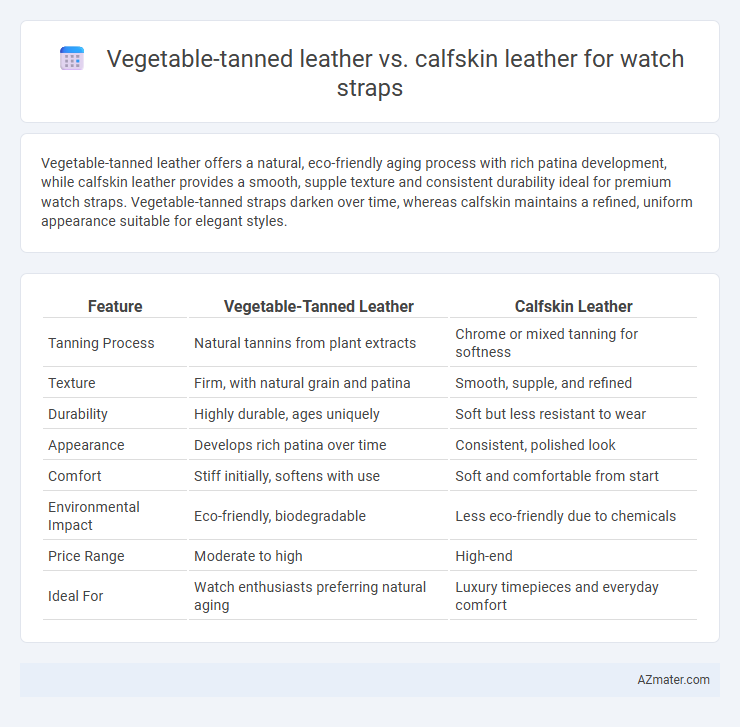Vegetable-tanned leather offers a natural, eco-friendly aging process with rich patina development, while calfskin leather provides a smooth, supple texture and consistent durability ideal for premium watch straps. Vegetable-tanned straps darken over time, whereas calfskin maintains a refined, uniform appearance suitable for elegant styles.
Table of Comparison
| Feature | Vegetable-Tanned Leather | Calfskin Leather |
|---|---|---|
| Tanning Process | Natural tannins from plant extracts | Chrome or mixed tanning for softness |
| Texture | Firm, with natural grain and patina | Smooth, supple, and refined |
| Durability | Highly durable, ages uniquely | Soft but less resistant to wear |
| Appearance | Develops rich patina over time | Consistent, polished look |
| Comfort | Stiff initially, softens with use | Soft and comfortable from start |
| Environmental Impact | Eco-friendly, biodegradable | Less eco-friendly due to chemicals |
| Price Range | Moderate to high | High-end |
| Ideal For | Watch enthusiasts preferring natural aging | Luxury timepieces and everyday comfort |
Introduction to Vegetable-Tanned and Calfskin Leather
Vegetable-tanned leather is crafted using natural tannins from tree bark, roots, and leaves, resulting in an eco-friendly, durable material that develops a rich patina over time. Calfskin leather, derived from young cattle, is prized for its fine grain, softness, and smooth texture, offering a luxurious and supple feel ideal for high-end watch straps. Choosing between vegetable-tanned and calfskin leather depends on preferences for natural aging characteristics versus refined finish and softness in watch strap materials.
What is Vegetable-Tanned Leather?
Vegetable-tanned leather is crafted using natural tannins extracted from tree bark and plant materials, resulting in a durable and eco-friendly material ideal for watch straps. This tanning process enhances the leather's ability to develop a rich patina over time, offering a unique, personalized appearance that improves with age. Compared to calfskin leather, vegetable-tanned leather is typically stiffer initially but becomes more supple and characterful with extended use, making it a favored choice for those seeking longevity and authenticity in their watch straps.
What is Calfskin Leather?
Calfskin leather is a premium, smooth, and supple material derived from young calves known for its fine grain and durability, making it a popular choice for high-quality watch straps. Unlike vegetable-tanned leather, which undergoes a natural tanning process using plant-based tannins, calfskin leather is often chrome-tanned, resulting in a softer and more flexible texture. Its ability to develop a rich patina while maintaining resilience enhances the aesthetic and longevity of watch straps crafted from this luxurious leather.
Appearance and Texture Comparison
Vegetable-tanned leather exhibits a rich, natural patina that deepens over time, offering a matte, rustic finish with unique grain patterns that highlight its organic tanning process. Calfskin leather provides a smoother, more refined surface with a consistent, fine grain and a glossy sheen that enhances the strap's luxurious appearance. Texture-wise, vegetable-tanned leather feels firmer and more textured initially, while calfskin is softer, pliable, and has a supple touch ideal for comfort and elegance on watch straps.
Durability and Longevity
Vegetable-tanned leather offers superior durability due to its natural tanning process, which enhances its resistance to wear and develops a rich patina over time. Calfskin leather, while softer and more supple, is less resistant to scratches and moisture, making it less ideal for long-term use in watch straps subjected to daily wear. For longevity, vegetable-tanned leather outperforms calfskin by maintaining structural integrity and aesthetic appeal through extended use.
Comfort and Wearability
Vegetable-tanned leather offers superior breathability and molds naturally to the wrist, enhancing comfort during extended wear. Calfskin leather, known for its smooth texture and flexibility, provides a softer feel and immediate comfort without a break-in period. Both materials ensure durability, but vegetable-tanned leather develops a unique patina over time, while calfskin maintains a polished appearance.
Sustainability and Eco-Friendliness
Vegetable-tanned leather for watch straps is more sustainable and eco-friendly due to its natural tanning process, which uses plant-based tannins and avoids harmful chemicals, reducing environmental impact. Calfskin leather, while known for its softness and durability, often involves more intensive chemical treatments and faster tanning methods that can contribute to pollution and resource depletion. Choosing vegetable-tanned leather supports more responsible sourcing and biodegradability, aligning with eco-conscious watch strap preferences.
Maintenance and Care Requirements
Vegetable-tanned leather watch straps require regular conditioning with natural oils to prevent drying and cracking, as they develop a rich patina over time but are more sensitive to moisture and sweat. Calfskin leather straps, known for their smooth texture and softness, need gentle cleaning with a damp cloth and occasional application of a leather conditioner to maintain suppleness, while offering better resistance to daily wear and moisture compared to vegetable-tanned counterparts. Both materials benefit from avoiding prolonged exposure to direct sunlight and humidity to extend the strap's lifespan and preserve its appearance.
Price and Value for Money
Vegetable-tanned leather watch straps tend to be more affordable due to their traditional tanning process using natural tannins, offering good durability and a unique patina over time, which provides excellent value for money. Calfskin leather straps, often pricier, are prized for their smooth texture and refined appearance, delivering a premium look and comfort that justifies the higher cost for luxury watch enthusiasts. Choosing between the two depends on budget preferences and the desired balance between natural aging characteristics and sleek aesthetics.
Which Leather is Best for Your Watch Strap?
Vegetable-tanned leather offers a natural aging process with a rich patina that develops over time, making it ideal for those seeking durability and character in their watch strap. Calfskin leather provides a smoother, softer texture with a fine grain, delivering an elegant and luxurious appearance suitable for formal wear. Choosing the best leather depends on your preference for rugged longevity with vegetable-tanned or refined sophistication with calfskin for your watch strap.

Infographic: Vegetable-tanned leather vs Calfskin leather for Watch strap
 azmater.com
azmater.com